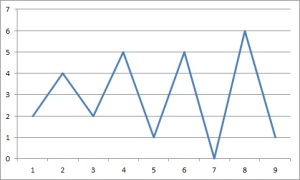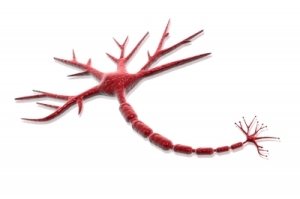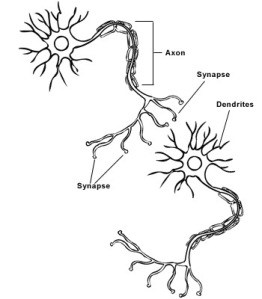Bipolar Affective Disorder used to be called Manic Depression. It affects from 1 – 2% of the population and affects men and women equally. Average age of onset is 15 – 25 years. It is difficult to diagnose, often co-occurs with a broad assortment of physical ailments and causes great distress for sufferers and their families.
People are often confused by this illness but it’s not too difficult to understand.
How many times have you woke up in a great mood. Your feet touch the floor and you know it’s going to be an amazing day. The traffic lights change as you approach and the lettuce you buy is always sweet.
Conversely, we have all had those days…you know you’ve had them, where you wake knowing it’s a miserable day. You’re grumpy and out of sorts and hate everything. Nothing goes your way, and everything irritates you.
Bipolar affective disorder looks like this:
For the sake of a simple discussion, let’s assume that the normal range of emotion occurs between 2 and 4 on the scale above. Those great days are 4 on the scale. But those other days are on 2. Most of us fluctuate between 2.5 and 3.5. (Remember I’m using a graph to demonstrate this disorder, NOT to suggest numerical ranges for our feelings.) When people have manic episodes, their highs go above the best that we feel. On the graph, these are the points 5 and 6. When people have depression, their moods drop below those bad days into another realm.
These cycles are beyond the control of the individual going through them. Talking, directives and therapy are not solutions for this disorder. It requires medication and extreme attentiveness to the person’s health and well being. But sometimes neither of these work and the individual goes through a repeated cycle of hospitalization and release.
The length of a cycle is measured from one peak or valley, to the next Rarely a person will cycle only once in a lifetime but more likely cycle several times per year.
By the way, the graph represents balanced cycles of the illness, but some people remain manic for much longer than they are in depression or vice versa.
Bipolar affective disorder is extremely hard to diagnose. It never goes away. (At best, medication is used to control the symptoms.)
If you look at the line above, you will notice that on the way from mania (a peak) an individual’s mood or affect will settle and move through normal into depression. Ditto on the way back up. People with this disorder show long periods of time when their behavior appears normal. And is. But these times are misleading, because they are simply part of the process of the disease. Up and down, alwaus passing through normal in each cycle. But of course the time spent within that normal range is determined by the length of each cycle.
At the extreme, Mania is the cycle of the illness that usually gets the most attention. In this phase, behavior is often publicly disordered. Symptoms include extremely high energy (feeling high), little if any sleep, rapid firing speech, increased sexual drive, increased recklessness without regard for the consequences, grandiosity and major thought disturbances. It is in this stage that people may read a book faster than they can turn the pages, or take off their clothes and dance down Main Street in the middle of rush hour. This is the time they ‘realize’ that the local pawn shop is mistakenly selling real diamonds for next to nothing and they will beg, borrow or steal money to buy all of them in every pawn shop in town. They may start binge drinking, drugging and eating. Or sleeping with anyone available. They may talk extremely fast and becoming extremely cunning and sly. Extreme drinking and drug use may also happen in a manic stage. Periods of extreme creativity are also common – paintings, books and musical scores often come from these periods, although their quality can be questionable. Ironically it is this ‘high’ that patients hate to give up. They feel accomplished, productive and super-capable in the manic stage.
When the body and brain are exhausted, the individual’s mood starts to slide down into normal. Often at this time, remorse, embarrassment and humiliation are common and sometimes overwhelming. Inevitibly depression takes over and the individual is full of self loathing and hopelessness. Suicide ideation or attempts happen at the bottom of the depressive stage, which mimics depression that is more common in society.
Psychosis, hallucinations and delusions may occur at either end of the spectrum.
Also, remember I’m talking generalities and clear, delineated stages, which isn’t how it happens. But I think it helps for understanding.
Treatment includes a regimen of psychotropic medication (drugs for the brain) and stress management. A friend of mine has this illness. As long as he is absolutely rigid about his sleep, exercise, nutrition and creative practices, he can live a productive and happy life. He has three teenaged children and is actively involved in their lives. He’s happily married too. But he is very clear, his mental health comes first. But remember, we don’t know where his illness lies on the continuum of mental health and illness. And his rigidity may not help the next person with BAD.
As always, people with this illness have a chemical imbalance in their brains that drives them to behave in ways that cause them and their loved ones embarrassment, shame and loss. But the next time you see someone behaving like this, say a prayer and send kind thoughts. If they could behave differently, they would.
There is some thought that this illness can show up in children as young as six. But in this situation, the cycles are usually hourly and the mania is expressed as rage. The problem is that none of the meds used to treat adults have been approved for children.
Another friend has a little girl who put her fists through walls at seven. She had been expelled from school because when she cycled, they couldn’t protect her or the other students.
Diagnosis took a long time (in part because of the illness and in part because psyciatrists are often loath to ‘label’ someone so young). But eventually they found the right meds and she settled down, becoming a normal, sensitive, happy little girl. She was a different child. Truly an amazing turn-around.
After eighteen months, the physical side effects of the medication were more serious than the illness so she was taken off them. Within weeks she was behaving in the same old ways with one exception: this time she knew how different her behavior was and why the other kids called her crazy. And then, this gorgeous little girl actively tried to take her life not once but twice.
She is twelve now and going through adolesence while dealing with the disease which is subdued by meds but not controlled. Their home is difficult, at best. A prayer for them would be appreciated.
Credit for fact verification and additional information is available at:
http://emedicine.medscape.com/article/286342-overview
http://www.obad.ca/information_bipolar
http://www.ncbi.nlm.nih.gov/pubmedhealth/PMH0001924/
http://www.ncbi.nlm.nih.gov/pubmedhealth/PMH0001924/
http://www.nimh.nih.gov/health/publications/bipolar-disorder/complete-index.shtml
Do you know anyone with this illness? Have you seen this behavior?














